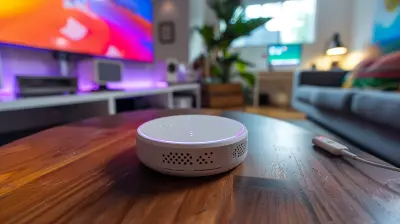How to Measure the Success of Your Robotic Process Automation Projects
20 July 2025
Robotic Process Automation (RPA) has become a game-changer for businesses looking to streamline operations, improve efficiency, and reduce human error. But implementing RPA is just the first step. The real challenge? Measuring its success.
How do you know if your RPA project is actually delivering value? Are you seeing tangible improvements, or is it just another shiny tech investment?
Let’s break it down in simple terms and look at the key ways to measure the success of your RPA projects.

Why Measuring RPA Success Matters
Imagine buying a high-tech coffee machine but never checking if it actually makes good coffee. Sounds pointless, right? The same applies to RPA.If you don’t measure the impact of your automation efforts, you won’t know if they’re working. Worse, you might keep throwing money at something that’s failing.
By tracking the right metrics, you can:
- Ensure your RPA investment is worth it
- Identify bottlenecks and fix them
- Improve efficiency and cost savings
- Get valuable insights for future automation projects
So, what should you measure? Let's dive in.

Key Metrics to Measure RPA Success
1. Cost Savings
One of the biggest reasons companies implement RPA is to save money. You need to compare costs before and after automation to see if you're actually spending less.How to Measure?
- Track manual labor costs before RPA- Compare operational costs after automation
- Calculate the return on investment (ROI)
A simple formula for ROI:
\[
ROI = \frac{{(Savings – Investment Cost)}}{{Investment Cost}} imes 100
\]
If the percentage is high, your RPA project is a win. If not, you may need to refine your automation strategy.
2. Time Saved
Time is money. If your bots are not reducing the time needed to complete tasks, then what’s the point?How to Measure?
- Monitor task completion times before and after RPA- Compare employee workload reduction
- Track processing speed improvements
Let’s say a process that took four hours now takes 30 minutes. That’s a clear indicator of success.
3. Accuracy and Error Reduction
Humans make mistakes. Bots? Not so much—if they’re programmed correctly. The fewer errors, the better.How to Measure?
- Compare error rates before and after automation- Track rework and correction efforts
- Monitor compliance improvements
If accuracy improves significantly and the need for human intervention decreases, your RPA bots are doing their job.
4. Scalability and Capacity
A successful RPA implementation should handle growing workloads effortlessly. If your bots struggle under increased demand, it’s a problem.How to Measure?
- Analyze the system’s ability to scale- Track the number of tasks or transactions processed
- Measure response times under peak loads
Think of it like upgrading from a bicycle to a sports car. Your automation should accelerate performance, not create bottlenecks.
5. Employee Productivity and Satisfaction
RPA isn’t about replacing employees—it’s about freeing them from repetitive tasks so they can focus on higher-value work.How to Measure?
- Conduct employee feedback surveys- Measure how much time employees save from automated tasks
- Track employee engagement and job satisfaction
If employees are happier and more productive, RPA is making a difference.
6. Business Process Efficiency
The goal of automation isn’t just to replace humans but to improve overall process flow.How to Measure?
- Evaluate end-to-end process execution time- Identify process bottlenecks before and after RPA
- Measure the impact on business continuity
If tasks are completed faster with fewer hiccups, your automation is working as intended.
7. Customer Experience Improvement
Happy customers equal business success. If RPA improves customer interactions, that’s a win.How to Measure?
- Analyze customer response times- Track customer complaints related to process delays
- Measure Net Promoter Score (NPS) before and after RPA
Faster response times and fewer complaints? That’s proof your automation is driving value.
8. Compliance and Risk Management
Regulatory compliance is crucial. If automation helps maintain compliance, it’s a major success factor.How to Measure?
- Track regulatory compliance breaches before and after RPA- Monitor risk management improvements
- Analyze audit trail quality and completeness
Fewer compliance issues mean your automation efforts are reducing risks.
9. Bot-to-Human Ratio
How many tasks are completed by bots versus humans? A rising bot-to-human ratio indicates greater automation adoption.How to Measure?
- Compare the percentage of automated tasks- Track the number of manual interventions required
The more bots can handle without human intervention, the more efficient your RPA system is.

Common Pitfalls to Avoid When Measuring RPA Success
Even with the right metrics, some mistakes can skew your assessment. Watch out for these pitfalls:1. Focusing Only on Cost Savings
Yes, saving money is important, but RPA brings other benefits like speed, accuracy, and scalability. Don't overlook them.2. Ignoring Employee Feedback
If employees hate the automation or find it frustrating, it’s a sign something’s wrong. Pay attention to their feedback.3. Not Considering Long-Term Scalability
Your RPA system should grow with your business. If it only works for your current needs, you might outgrow it too soon.4. Overlooking Integration Issues
RPA should seamlessly integrate with existing systems. If it’s causing disruptions, you might need to rethink your approach.
Final Thoughts
Measuring RPA success isn’t just about numbers—it’s about real-world impact. Are your processes running smoother? Are your employees happier? Are your customers benefiting?If your automation efforts check these boxes, then congratulations—you’ve got a successful RPA implementation. If not, it might be time to fine-tune your approach.
At the end of the day, RPA should work for you, not the other way around. Keep measuring, keep optimizing, and watch your business transform.
all images in this post were generated using AI tools
Category:
Robotic Process AutomationAuthor:

John Peterson
Discussion
rate this article
1 comments
Gabriel Bishop
This article promises valuable insights! I'm eager to learn about key metrics for evaluating RPA success—what benchmarks should we prioritize?
July 21, 2025 at 3:34 AM

John Peterson
Thank you! Key metrics to prioritize include ROI, process efficiency improvements, error reduction rates, and user satisfaction levels. These will give you a comprehensive view of RPA success.


